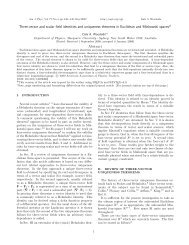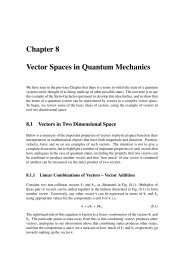Electrostatic Fields in Matter
Electrostatic Fields in Matter
Electrostatic Fields in Matter
You also want an ePaper? Increase the reach of your titles
YUMPU automatically turns print PDFs into web optimized ePapers that Google loves.
9 Boundary Conditions.What happens at the junction of two dielectrics?In the figure, the dielectric above the horizontal l<strong>in</strong>e has permittivityɛ 1 , while below the l<strong>in</strong>e it is ɛ 2 .ε1ε2Dn1Dn2Et1Et2Take the Gaussian pill-box on the left <strong>in</strong> the figure and imag<strong>in</strong>eits height goes to zero. If there is no free charge at the boundary,there is no net flux of ⃗ D out of the pill-box. Hence the boundarycondition for ⃗ D is:D n1 = D n2 (24)We also know that the l<strong>in</strong>e <strong>in</strong>tegral of the electric field aroundthe rectangle on the right must be zero (s<strong>in</strong>ce ∇ × ⃗ E = 0). As weimag<strong>in</strong>e the rectangle shr<strong>in</strong>k<strong>in</strong>g to an <strong>in</strong>f<strong>in</strong>itesimal size, we see that:E t1 = E t2 (25)i.e. across the boundary of 2 dielectrics, the normal component of⃗D is cont<strong>in</strong>uous and the tangential component of ⃗ E is cont<strong>in</strong>uous.13
















